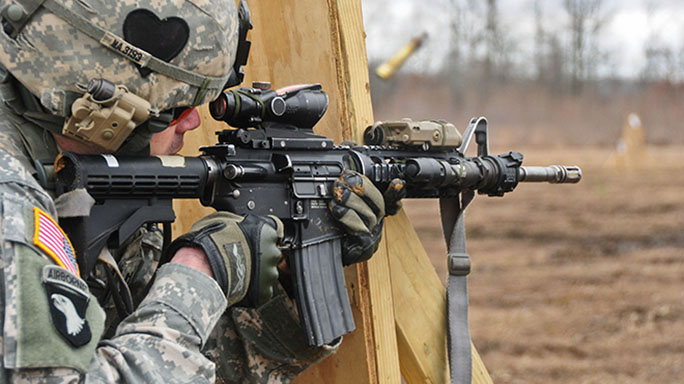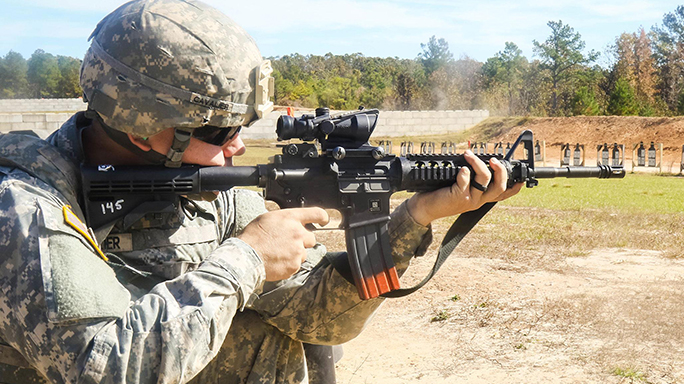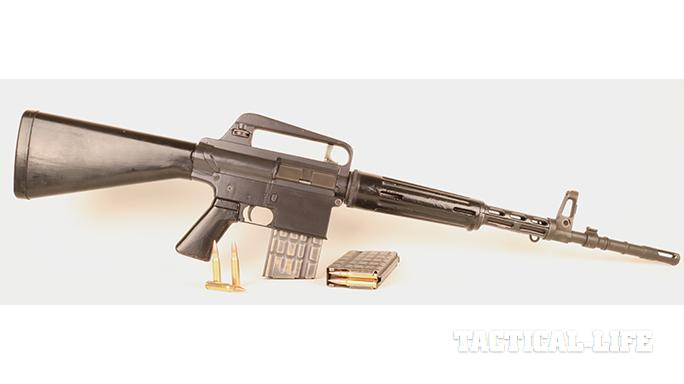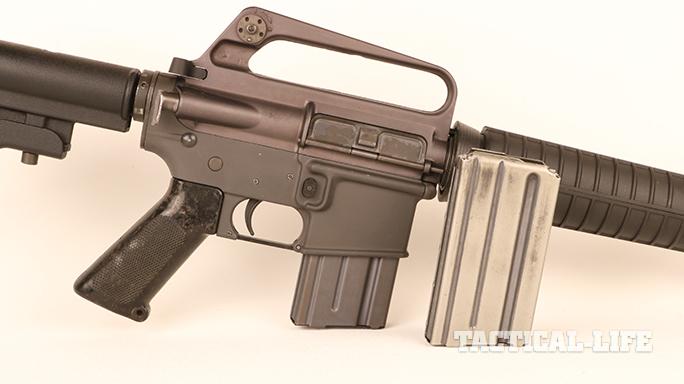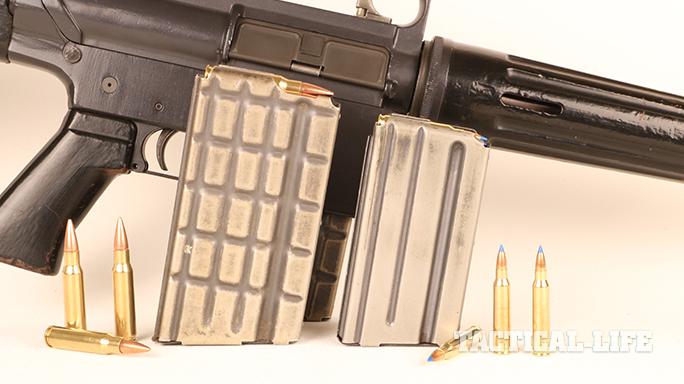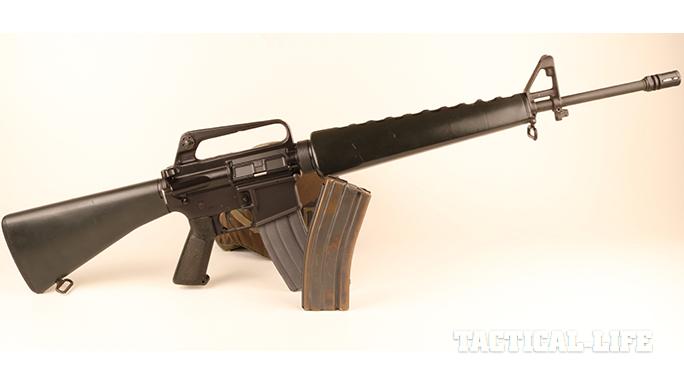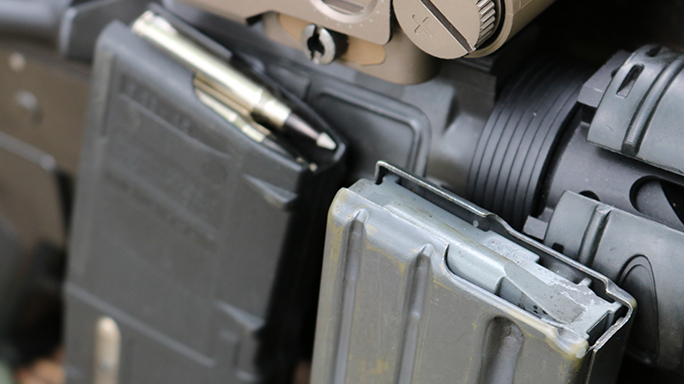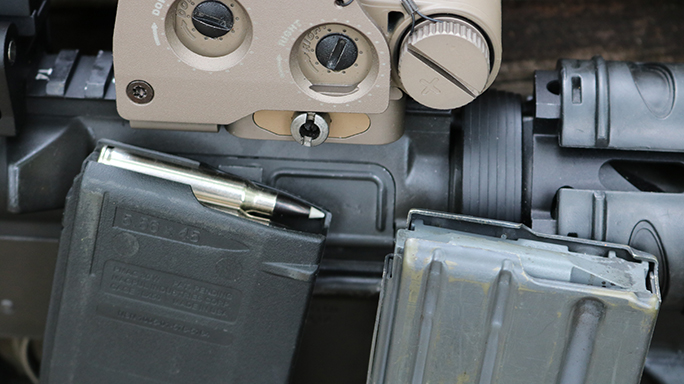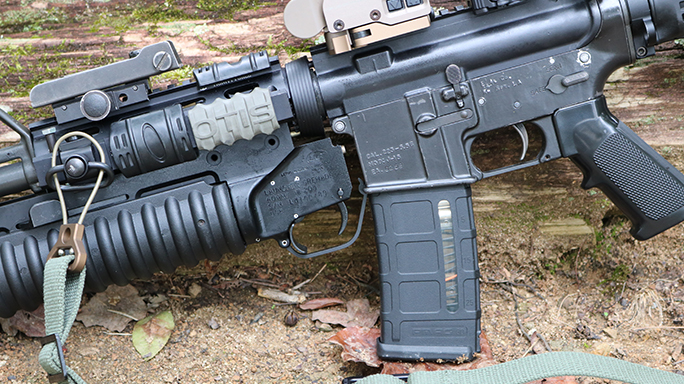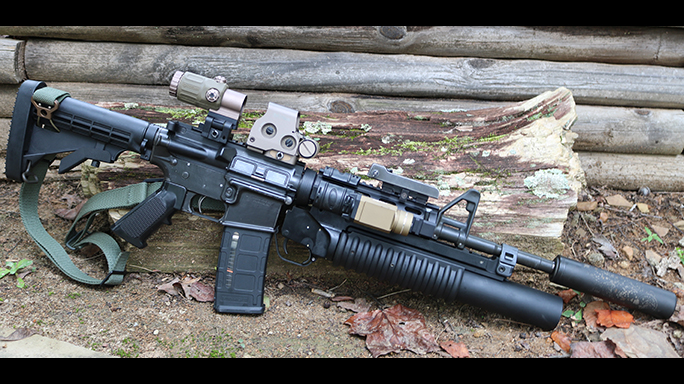Bang, bang, crap. Bang, bang, crap. Repeat as necessary. The year was 1987. The place was Fort Benning, Ga. The weapon was a Colt M16A1 that I had meticulously maintained.
This was a bolt-over-base malfunction. SPORTS—or “Slap, Pull, Observe, Release, Tap, Squeeze,” what we were taught to do as immediate action in the event of a malfunction—wouldn’t fix it. In this case, the bolt slips past the base of the cartridge and catches it amidships. Most commonly, friction will carry the round partially out of the magazine and dent the body of the cartridge case, locking the bolt half open. To fix the stoppage, you have to lock the bolt to the rear, remove the magazine, clear the damaged round, reload and fire. Even under perfect conditions, that takes a while. The culprit this particular day was not the rifle, but its rubbish magazine.
Origin Story
In 1955, Eugene Stoner completed design work on a most remarkable firearm. The AR-10 melded modern state-of-the-art materials science drawn from the 1950s-era aircraft industry into several existing gun designs. The magazines for the original AR-10 were pressed from light-gauge aluminum and imbued with a waffle pattern to enhance their rigidity. They were originally intended to be disposable.
Advertisement — Continue Reading Below
The AR-10 eventually morphed into the AR-15/M16. The gun’s magazines plodded predictably along this same evolutionary track. When the M16 hit the streets, the lightweight, pressed-aluminum magazines of the AR-10 were simply miniaturized to accommodate it. The waffle pattern became the more familiar longitudinal grooves, but the concept was the same. Ultimately, the small, boxy 20-rounders were replaced by 30-round magazines.
The lightweight magazine bodies were mightily susceptible to denting, but the biggest problem rested with the followers. The lack of no-tilt legs on those old cast-aluminum followers is what created such a headache for me that day so long ago at Fort Benning. The result was that bolt-over-base stoppage that was such a pain to clear.
Now fast-forward some 30 years and the U.S. Army’s new aluminum rifle magazines have had an extreme makeover. They now sport high-tech polymer followers with molded-in legs to keep the round stack upright. These modern followers are dyed either green or tan for visibility. These Information Age examples are radically more reliable than their forebears. The question, however, is can do we better still?
Advertisement — Continue Reading Below
- RELATED STORY: Feeding Frenzy – Charting the History of AR Magazines
Modern kinetic festivities are pitiless and fast. Often the one with the best stuff wins. When your hide is on the line, you will do whatever it takes to keep the edge. Sometimes that means personally purchased magazines. But if Big Army allowed you to bring whatever you wanted into combat, some lunkhead would inevitably parachute into a warzone wearing leotards and a tutu. The Army invests a breathtaking amount of time and resources in rigorously testing killer gear. This process is by definition cumbersome. It may also not be completely without bias.
The aluminum Enhanced Performance Magazine (EPM) represents the latest general-issue magazine for the Army. However, three government-backed tests have now established that the Army EPM has a critical deficiency. In the most recent and most comprehensive U.S. government test, the Army EPM failed to even reach minimum government standards due to the feed failure rate. It was this documented feed failure rate that caused the USMC to take the extraordinary action of banning USGI magazines from combat use.
Our buddies in the Marine Corps recently burned about a zillion rounds to determine that the polymer Magpul PMAG GEN M3 magazine is actually the best AR magazine on the planet. Might it not be time for the Army to ponder a similar change?
Advertisement — Continue Reading Below
If ever there was an oxymoron, it would be “jarhead science,” but our Devil Dog buddies tortured every popular AR magazine in the world to determine which one worked best. After an extensive and grueling competition, the Magpul PMAG GEN M3 was selected to equip the entirety of the U.S. Marine Corps. This newest PMAG incorporates transparent windows to assist in keeping track of the remaining rounds. It also fits all standard Marine Corps 5.56mm weapon systems, including the M4/M16, M27 IAR and M249 SAW. These magazines will be provided in both black and medium coyote tan. The new PMAG GEN M3 is now the only magazine authorized for combat in USMC units.
Expert Commentary
Len Waldron, a former U.S. Army infantry officer and gun writer, said, “I have been using Magpul magazines in my AR since they hit the market and have continued to see the company improve the product for shooters and servicemen. The only argument against polymer that I have ever heard that made even a little sense was in extremis situations; a damaged aluminum magazine could be bent back into shape and made to function, where a polymer mag would break. This might be true, but one would also have to ask if the polymer would have flexed where the aluminum bent. If independent choice is any indicator, civilians, LEOs and military shooters in elective training are rarely seen with anything but polymer mags.”
Mike Detty, a retired Marine and prolific gun writer, said, “I like the lubricious nature of the polymer, which makes them easy to load and enhances feeding. I also like that they can quickly be disassembled and hosed out. Polymer has the advantage of being able to flex while aluminum does not, and I have never had a PMAG that doesn’t fall free from the rifle. If there is a downside to Magpul’s PMAGs, I have yet to find it!”
Advertisement — Continue Reading Below
John Buol, a military small arms instructor, gun writer and member of the U.S. Army Reserve Competitive Marksmanship Program, offered, “There are good, reliable modern polymer magazines, especially the GEN M3. However, the ‘legacy’ aluminum design with the current follower (green or tan) is also a good magazine. Personnel on shooting teams competing in Service Conditions events and similar tend to prefer the aluminum magazines. Most of the complaints against current-issue aluminum magazines come from personnel and units abusing them—usually the same personnel complaining that the M16/M4 is unreliable.”
From The Horse’s Mouth
Duane Liptak, Magpul’s EVP, told me, “At Magpul, we had to make a better product or there would be no reason for our existence. So, we’ve dedicated a tremendous amount of resources to understanding the science and physics of feeding ammunition into firearms, and the best materials, geometries and properties to use. We have a lot of prior service members here at Magpul, and many have our sons and/or daughters serving currently. Yes, we want the company to be successful. But with our own friends, relatives and children currently serving—including my own two oldest sons—we are absolutely driven to make the best product possible.
“We know the importance of the magazine, and what a PMAG can do for reliability. Reliability saves lives. Every stoppage in combat could cost someone their life. That’s why we’ve worked so hard to achieve the flawless reliability shown in the body of government testing.
Advertisement — Continue Reading Below
- RELATED STORY: 16 Rugged and Reliable AR Magazines
“The reliability of the PMAG was recognized by end-users early on, and there have been millions in combat from the first generation up through the GEN M3. That’s the part that makes adoption easy—the PMAG has essentially already been fielded in massive numbers for the last decade, so the performance in real usage is already known.
“We are still at zero magazine-related stoppages over many tens of thousands of rounds in government testing. As a result, after looking at all the firing data, as well as the cold weather, hot weather, dust, salt fog, UV, chemical and drop testing, the USMC adopted the 30-round PMAG GEN M3 Window as the only magazine that they would take into combat in late 2016.
“Ammunition types, shorter gas systems and expectations in different operational environments have changed over the years, and the efforts to improve the USGI magazine haven’t kept pace with what is truly possible. ‘Acceptable performance’ is a dangerous term. When one stoppage can cost someone their life, how many magazine-related stoppages are ‘acceptable’ when you don’t need to accept any at all by using the PMAG?”
Advertisement — Continue Reading Below
Army EPM Testing
There is some compelling chatter coming out of Aberdeen implying that the latest aluminum Army EPM may struggle to meet reliability standards with the Army’s latest M855A1 rounds. The newest Magpul PMAG GEN M3s are unambiguously superlative across the board. In a profession where your life depends upon the performance of your equipment, little things can become big things.
Ours is the most powerful nation on the planet, and we enjoy the luxury of being able to afford the absolute best for our men and women serving downrange. The Marines have recently invested a tremendous amount of time and effort in selecting the Magpul PMAG GEN M3. As painful as it is for this former Army officer to admit, it might just be time to follow the Marines’ lead.
Editor’s Note: It was recently announced that the Air Force has adopted GEN M3 PMAGs. The USAF’s decision to replace its current standard-issue magazine with the PMAG follows similar announcements by the U.S. Marine Corps and USSOCOM. These decisions follow multiple U.S. government tests that found the current Army EPM failed to meet minimum standards based on high feeding failure rates.
Advertisement — Continue Reading Below
This article was originally published in “Tactical Weapons” November/December 2017. To order a copy and subscribe, visit outdoorgroupstore.com.
